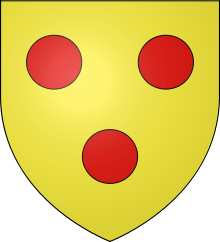House of Courtenay


House of Courtenay is the name of two distinct noble families, both of which descended from Athon. Athon, the first lord of Courtenay (Seigneur de Courtenay), was himself apparently a descendant of the Counts of Sens and from Pharamond, reputed founder of the French monarchy in 420. Athon took advantage of the succession crisis in the Duchy of Burgundy between Otto-William, Duke of Burgundy and Robert II of France to capture a piece of land for himself, where he established his own seigneury (lordship), taking his surname from the town he founded and fortified.
The Split
In the 12th century, Renaud de Courtenay (d.1190), son of Milo de Courtenay (d.1127), moved to England after quarreling with King Louis VII:
The Capetian House of Courtenay
- His daughter, Elizabeth, was given in marriage, together with his forfeited French lands, by the French Capetian King Louis VII with whom he had quarreled, to his youngest brother Peter of France (d.1183), henceforth known as Peter I of Courtenay. Peter and Elizabeth's descendants were members of the Capetian House of Courtenay, a cadet branch of the House of Capet, the French Royal House. Their descendants acquired through marriage the County of Namur and the Latin Empire of Constantinople. This branch became extinct in the male line in 1733, with the name Courtenay passing on to the Bauffremont family. A cadet branch of the Courtenay that participated in the crusades came to rule the County of Edessa, a Crusader state. It became extinct in the male line around 1200. See also the Houses of Montlhéry and Le Puiset.
Claim to French royal status
The House of Bourbon, which acquired the French throne with Henry IV of France, was another cadet branch of the Capetian dynasty. Under the Salic law, males descended in male line from Hugh Capet are princes of the blood—i.e., they have the right to succeed to the French throne in the event that the male line of the royal family and of more senior princes die out. Hence, the then impoverished Capetian House of Courtenay, being agnatic descendants of Louis VI of France, sought to be acknowledged as "princes du sang" (Princes of the Blood Royal) and "cousins to the king," two titles normally reserved for the members of the royal family and prized for the seats at the Royal Council and the Parliament of Paris that they conferred upon its holders. Three Bourbon kings in a row - Henri IV, Louis XIII, and Louis XIV - turned down their petitions. That the Bourbon monarchs confined the French royalty to the descendants of Louis IX is evidenced by the Treaty of Montmartre (1662) which named the non-Capetian House of Lorraine as the next in line to the French throne after the Bourbons, thus bypassing the Courtenay branch, a Capetian family. Although the Courtenays protested against this clause, their claims to the princely title were never acknowledged by the Paris Court of Accounts. The last male member of the French Courtenays died in 1733, but his niece married the Marquis de Bauffremont, and her descendants assumed the title of "Prince de Courtenay" with dubious validity, which they bear to this day.
The English House of Courtenay
- His son, Robert de Courtenay (d.1242), feudal baron of Okehampton, Devon, in right of his mother Hawise de Curci (d.1219),[1] married Mary de Redvers, daughter and heiress of William de Redvers, 5th Earl of Devon (d.1217). His great-grandson Hugh de Courtenay, 9th Earl of Devon (d.1340) inherited the Earldom of Devon in 1335 on the extinction of the male line of the de Redvers family. The title was subsequently recreated for Hugh de Courtenay, nephew of Hugh the elder Despenser. The family is one of the most ancient in England, currently headed by Charles Courtenay, 19th Earl of Devon.
Genealogy
- Athon
- Joscelin I of Courtenay, married 1. Hildegarde de Gâtinais (sister of Geoffrey III of Anjou), 2. Isabel de Montlhéry, daughter of Guy I of Montlhéry
- Hodierna, married Geoffrey II, Count of Joinville
- Miles of Courtenay (d.1127), married Ermengarde of Nevers
- William of Courtenay
- Joscelin
- Renaud de Courtenay (d.1190), married firstly Hélène du Donjon, secondly after his move to England, Hawise de Curcy (d.1219), heiress to the English feudal barony of Okehampton, Devon [2]
- Robert de Courtenay (d.1242) feudal baron of Okehampton, married Mary de Redvers, d. of William de Redvers, 5th Earl of Devon (d.1217)
- John de Courtenay (d.1274)
- Hugh de Courtenay (d.1292)
- John de Courtenay (d.1274)
- Elizabeth, married Peter I of Courtenay (d.1183), son of Louis VI of France
- (Capetian branch)
- Robert de Courtenay (d.1242) feudal baron of Okehampton, married Mary de Redvers, d. of William de Redvers, 5th Earl of Devon (d.1217)
- Joscelin I, Count of Edessa, married 1. Beatrice (daughter of Constantine I of Armenia), 2. Maria of Salerno (sister of Roger of Salerno)
- Joscelin II, Count of Edessa, married Beatrice
- Joscelin III of Edessa, married Alice of Milly
- Beatrix de Courtenay, married Otto von Botenlauben (Count of Henneberg)
- Agnes, married William of La Mandelie
- Agnes of Courtenay, married 1. Reginald of Marash, 2. Amalric I of Jerusalem, 3. Hugh of Ibelin, 4. Reginald of Sidon
- Isabella of Courtenay, married Thoros II of Armenia
- Joscelin III of Edessa, married Alice of Milly
- Joscelin II, Count of Edessa, married Beatrice
- Geoffrey Chapalu
- Joscelin I of Courtenay, married 1. Hildegarde de Gâtinais (sister of Geoffrey III of Anjou), 2. Isabel de Montlhéry, daughter of Guy I of Montlhéry
Bibliography
References
| Wikisource has the text of the 1911 Encyclopædia Britannica article Courtenay. |
- ↑ Sanders, I.J., English Baronies, Oxford, 1960, pp.69-70, Okehampton
- ↑ Renaud is identified as husband of both these two ladies by Cleaveland, Ezra, A Genealogical History of the Noble and Illustrious Family of Courtenay, Exeter, 1735, part III, pp.116-117